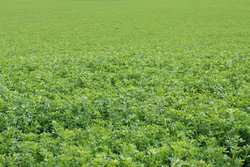This herbicide can help to “manage foliar diseases in glyphosate-tolerant alfalfa
By Patrick Lynch
Farms.com
Greenhouse research by USDA and University of Minnesota researchers has shown that spraying glyphosate on Roundup Ready alfalfa reduces the amount of rust on alfalfa plants. When four-week old plants were sprayed with glyphosate and then inoculated with rust, the rust did not spread.

Treatment increased protection from anthracnose and reduced symptom severity for spring black stem and leaf spot. The research report concluded that “these results indicate that glyphosate could be used to help manage foliar diseases in glyphosate-tolerant alfalfa.”